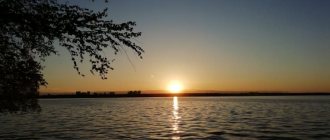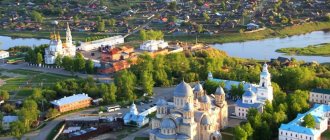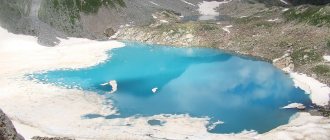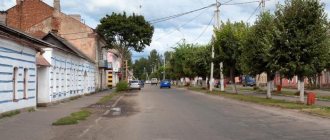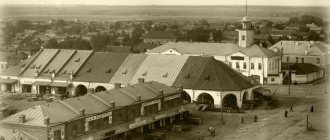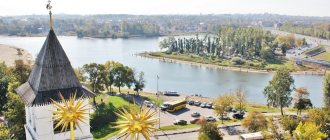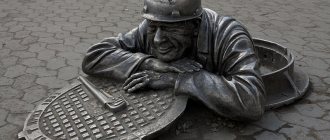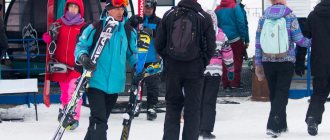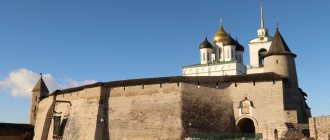The corner of Russia where the legend of Sadko took place, and in the 12th century they already knew what plumbing and democracy were - this is the Novgorod region. A land in whose forests you can disappear without a trace, accidentally ending up in the Valley of Death or the Killer Glade. Or return, but go crazy after spending several days in the Devil's Swamp. An area where residents are no longer afraid of UFOs and Bigfoot from the Malovishersky forest, whose name, by the way, is Avdoshka.
But the region is not only famous for this; a large number of cultural heritage sites associated with the names of famous people have been preserved here: Prince Rurik, Alexander Nevsky, S.V. Rashmaninov, A.S. Arensky, A.V. Suvorov, N.A. Nekrasov, E. N. Uspensky and F. M. Dostoevsky.
Cities and villages
Velikiy Novgorod
In the legends of the Scandinavians, Novgorod is found under the name Holmgard, which means “a city that goes under water during floods.” It’s not surprising, because there are many bodies of water around. One river divides the city into 2 parts. Previously, these halves fought with each other.
According to legend, Perun is involved in the feud, whose statue the merchants threw into the Volkhov. He swam to the bridge and threw a stick at it with the words: “Here is a souvenir from me, Novgorodians.” After this, regular massacres took place on the bridge.
- Rurik settlement. It is believed that the city was originally located here. But, according to archaeological excavations, it became impossible to continue development, so a new fortress was founded. It was this event that determined the name of the settlement: the new city - Novgorod.
- Novgorod Detinets is one of the oldest surviving kremlins in our country. It was the first in Rus' to be built of red brick. It was here that the trend for battlements began.
- Saint Sophia Cathedral. The western gate of the temple comes from Sweden. In the 12th century they were brought as a trophy, which turned out to be so valuable that 500 years later the Swedes tried to return it. From the Great Patriotic War until 2002, the cross of the cathedral was in Spain, where it was taken after one of the bombings. According to legend, the bird on it is a dove, petrified from the horrors that took place in the city during the massacre of Ivan the Terrible. The cathedral houses the miraculous icon of the Mother of God “The Sign”, which once saved the city from invaders.
A detailed guide to Veliky Novgorod: why go here and what to see.
Valdai
The city is named after the lake on the shore of which it is located. In the very center of Valdai, a map with all the attractions is drawn on the wall of a residential building. Another way to get around the city is the metro. True, it is virtual. But, despite this, tourists will be willing to sell a diagram with stations-attractions and even a real token.
- Bell Museum. During the time of Ivan the Terrible, it was decided to transport the bell from St. Sophia Cathedral to Moscow. But on the Valdai Mountains the sleigh skidded and overturned. The bell fell and crumbled into many small bells. Local residents collected them and made copies. It is believed that the Valdai bell brings happiness to the home.
- The museum of the county town is a family album of Valdai. Here the story is told through the fates of local residents, household items, habits, legends and photographs.
- The holy spring "Tekunok" is located near the city. Its water has healing powers: it cures eye diseases.
How to get to Valdai, what is important to know when coming here and what to do here.
Staraya Russa
According to legend, the city was founded by the knight Rus, who wandered around the country until he found this place. Scientists date the appearance of Staraya Russa to the end of the 10th century, but locals believe that it existed 2.5 thousand years BC. e.
Not far from the city there is an unusual forest in which there is no echo. According to legend, a lonely landowner lived in it, in whose garden there were watermelons, bamboo, melons and other exotic plants.
- House-Museum of F. M. Dostoevsky. The writer’s biographers note that Staraya Russa was the only place he chose to live himself. “Demons”, “The Brothers Karamazov”, an article for “A Writer’s Diary” and “Teenager” were written here.
- The monument to the infantrymen of the Wilmanstrand Regiment is dedicated to the participants of the Russian-Japanese War. Its construction was sponsored by Nicholas II, who personally escorted the soldiers to the battlefield. On top of the five-meter-high obelisk sits an eagle with outstretched wings, one of which was pierced by bullets during the Great Patriotic War.
- The Staraya Russa resort was visited by N. Dobrolyubov, K. Stanislavsky and M. Gorky. The first theater in the province was formed here, where V.F. Komissarzhevskaya began her career. At the end of the 19th century, it was the place of work of the first Russian woman to become a doctor of medical sciences - V. A. Kashevarova-Rudneva.
What else is worth knowing about Staraya Russa for those who are going here?
Valdai
“I don’t have fast or slow marches. Forward! And the eagles flew!” - Alexander Vasilyevich would exclaim to us, sending us to the third “point” of our wonderful journey. Although it is very difficult to call Valdai a point. This is a whole district in the Novgorod region, a city and a hill. Do you want unity and harmony with nature? Head here.
Photo: kladez-zolota.livejournal.com
It is impossible to describe Valdai in a few words, it is worth seeing. The picturesque region and emerald forests, crystal clear lakes and the splashing of springs, the voices of birds and ringing silence, ancient temples and an ancient city - they say that once you come here, you will never forget the beauty of this land. It's like something magical will pull you back. More than one song has been written about Valdai.
Maybe the fact is that this place is marked by higher powers? On a small island of Lake Valdai stands the famous Iversky Monastery, which appeared in the 17th century. Despite the fact that only a part of the temples and buildings have been preserved, tourists and pilgrims are drawn here to rest their thoughts and souls, and to worship the holy place. The doors of the Epiphany and Assumption Cathedrals are open to everyone, you will be received in the Church of the Archangel Michael and Jacob of Borovichi. At the monastery there is a small museum dedicated to Patriarch Nikon, the founder of the monastery.
In Valdai (and in the city of the same name) there are several museums and protected areas that will help you learn much more about the history and nature of the area, because this region is rich in legends and events. The Valdai Museum of the county town, the Bell Museum, landowner estates of the 18th-19th centuries - and all this in the “exterior” of the southern taiga.
There are routes throughout the Valdai National Park, and cultural events are regularly held on the shores of the lake. We recommend that you set aside a few days for your trip here, especially since you will always find hospitable houses and open people here.
Natural attractions
Valdai Lake
Coordinates: 57°59′00″, 33°18′00″ How to get there: by train, car, bus; The nearest settlements are Valdai and Roshchino.
According to legend, the lake got its name from the name of a beautiful young man who came to him to wash himself every day at dawn. The water, reflecting the beautiful face, woke up and began to splash. And in the noise of the waves one could hear “Valda, Valda, Valda.”
According to another version, the name of the lake was given by Finno-Ugric tribes. In their dialect it means “bright, living water.”
There is also a version that Valdai comes from the Moldavian “balte”, i.e. “lake in a swampy region” or from the Slavic “volot”, which translates as “lord”.
Seliger
Coordinates: 57.480206, 33.046304 How to get there: by bus or personal transport, the nearest settlements are the village. Polnovo, Ostrov village, Novy Skrebel village.
In ancient times, brothers Ilmen and Seliger fell in love with the same girl - Volga. The beauty chose Seliger, but Ilmen could not stand it and cursed his opponent.
He curled up and could not get up from the ground. Ilmen realized that he had done something terrible and, to punish himself, he lay down next to his brother. This is how the lakes of the same name appeared.
Valdai National Park
Visitor center address: Valdai, st. Pobeda, 5 Phone: 8(1666)2-94-92 Website: valdaypark.ru Opening hours: expositions - Tue-Sat 10:00-16:00, visitor center - Mon-Fri 08:00-17:00, hotel under reconstruction until March 2022. Cost: depending on the excursion, from 100 rubles per person.
The park is considered the most beautiful place in central Russia . It stretches for 105 km and includes 151 settlements. On its territory:
- 70 lakes and 20 rivers;
- pine forests, birch groves, meadows;
- There are about 200 species of animals, 6 of which are listed in the Red Book;
- recreation centers and hotels are equipped for tourists;
- there is a visitor center with interactive exhibitions;
- Neolithic sites of the 3rd-2nd centuries BC have been preserved;
- there are long mounds of the 6th-9th centuries;
- The Ignach-Cross monument was erected in honor of the liberation of the region from the Tatar-Mongol yoke.
Waterfall on the Priksha River
Coordinates: 58.818270, 33.611238 How to get there: by car; the nearest settlement is the village of Galitsa; from the parking lot with a sign to the waterfalls 5 minutes.
Priksha is a shallow river whose bed runs through a picturesque spruce forest. Not far from the village of Galitsa it passes through a hill made of limestone.
The current has eroded a shallow canyon in it, which has a cascade of two small waterfalls.
The passage to them is equipped, you can visit in any weather and time of year.
Kurgan Shum-gora
Coordinates: 58 30.388, 30 14.689 How to get there: by car 20 km from Batetsky village (20 min.)
According to one legend, Shum Mountain got its name from the crying that comes from it when it rains.
In another way - because it can be heard from a church service taking place in a neighboring village. Although there is an opinion that the church is buried inside the mountain right with the parishioners, and the sound comes from it.
It is also believed that the grave of Prince Rurik is located somewhere here.
Alcoholics and idlers do not take root in the vicinity of the mountain: people disappear or accidents happen to them. The mound cannot be opened - trouble will come. When an expedition was sent here in 1941, war suddenly broke out.
Museum "Estate of the Medieval Rushanin"
Museum "Estate of the Medieval Rushan". Velikiy Novgorod. Photo: Sergey Afanasyev / photobank “Lori”
The reconstruction museum “Estate of the Medieval Rushanin” is located in Staraya Russa. It was built in the historical part of the city, where archaeologists during excavations discovered the remains of ancient buildings and stone pavements.
All museum buildings are stylized as the home of a wealthy citizen of the 12th century. The residential wooden hut, in which the furnishings of that time were recreated, is surrounded by barns for storing supplies, a bathhouse, and a forge. There is also a saltworks located here: since ancient times, the residents of Staraya Russa have been engaged in salt production. All the equipment in it can still be used now, although some items have been preserved from the 12th–13th centuries. There is even a wooden water pipe that supplies water from a salty source.
Next to the saltworks, according to tradition, there is a large woodshed. It took a lot of wood to fire the furnaces where the salt was evaporated, so on estates it was always prepared several months in advance. A three-story tower is adjacent to the residential building. On its upper tier, mushrooms, berries and herbs were dried in the summer. Supplies were stored on the lower floors. During the holidays, guests could sleep here if there was not enough space in the hut. They often slept side by side, hence the name of such a tower.
The museum often hosts ethnographic festivals, historical reconstructions, and concerts of folk groups of the Novgorod region. On such days, guests can not only get acquainted with the life of an old Russian estate, but also listen to folk songs, try themselves as a blacksmith or warrior, learn how to weave bast shoes or take part in traditional Russian games.
Historical places
German Memorial Cemetery
Coordinates: 57.716446, 31.972604 How to get there: by personal transport from the village of Korpovo 2 min.
More than 30 thousand soldiers are buried in the German cemetery in the village of Korpovo. Their remains are brought here from all over the region.
Mass death sites are carved on one of the stones. The cemetery was designed and built by the Germans, and order is maintained at their expense.
They say that the paths are cleared here, even when the entire village is waist-deep in snow.
Travel Palace of Alexander I
Address: Korostyn village, st. Ozernaya How to get there: bus or car, 1 hour from Veliky Novgorod Opening hours: under restoration
The palace is a two-story mansion decorated with columns. It was built by the architect Vasily Stasov for Alexander I on the shore of Lake Ilmen.
An orchard with trees from the times of Catherine II has been preserved here.
At the moment, the estate is under restoration, which will last until the end of 2022. After which it will house a clay toy museum dedicated to the Ilmen Glint. This is a 15-meter cliff on the shore of the lake, which is a protected natural monument.
Vitoslavlitsy
Coordinates: 58° 31′ 32.0513″, 31° 16′ 27.0941″ Phone: 8(1627) 9-21-50 Website: novgorodmuseum.ru Opening hours: May-August 10:00-20:00, October - March 10:00-16:00, September and April 10:00-18:00 Cost: children under 16 years old - free, students - 120 rubles, adults - 170 rubles; group excursions from 640 rub. How to get there: bus, personal transport; from Veliky Novgorod 1.5 hours and 20 minutes.
The first exhibit of the museum of wooden architecture was the Church of the Assumption of the Virgin Mary (1595). She was transported here from the village. Kuritsko in 1964.
Today, huts, chapels and churches form real streets. There is even a stable and a goat shed. Here they show how animals are cared for, from cleaning and milking to shoeing.
Inside the exhibits there are exhibitions with interactive elements. Visitors can here:
- visit one of 6 exhibitions introducing peasant life;
- watch the craftsmen at work;
- take part in games and celebrations;
- take a master class on felting wool products.
House-Museum of Nekrasov in Chudovo
Address: Chudovo, st. Kosinova, 1 Phone: 8(1665) 5-42-67 Website: novgorodmuseum.ru Opening hours: Tue-Sun 10:00-17:00 Cost: children under 16 years old - free, students - 60 rubles, adults - 120 rub., excursions from 320 rub.
Nikolai Alekseevich came to Chudovo to take a break from the worries of the city, to hunt, and to communicate with people. It was here that the poet met his last love and wife.
Here the “Monster Cycle” of 11 works was born, work began on “Contemporaries” and the 4th chapter of the poem “Who Lives Well in Rus'” was written.
At one time, many of the poet’s friends visited the estate: G. I. Uspensky, M. E. Saltykov-Shchedrin, N. K. Mikhailovsky, A. N. Pleshcheev.
The first exhibition was opened in 1971. Today here you can see interiors from Nekrasov’s times and personal belongings of the poet’s family.
House-Museum of G. I. Uspensky
Address: Syabrenitsy village, st. Radishcheva, 73 Phone: 8 (1665) 4-16-94 Website: novgorodmuseum.ru Opening hours: Mon-Sun 10:00-18:00, Tue, Wed - weekends Cost: children under 16 years old - free, students - 60 RUB, adults - 120 RUB, excursion from 320 RUB. How to get there: bus or personal transport, 10 minutes from Chudovo.
The writer lived with his family in the village of Seryabrenitsy for a year. Later, it was here that the only museum in Russia was opened in his honor. The following works were written in this house:
- "Power of the Earth";
- "Quarter Horse";
- “Petka’s career”;
- "Live numbers".
Museum-Reserve of A.V. Suvorov
Address: s. Konchansko-Suvorovskoye, st. Central, 19 Phone: 8(1664) 9-85-33 Website: novgorodmuseum.ru Opening hours: Mon-Sun 10:00-16:00 (autumn-winter), 10:00-17:00 (spring-summer) ; Tue - closed Cost: children under 16 years old - free, students - 120 rubles, adults - 240 rubles, excursion from 320 rubles. How to get there: bus or car, 3 hours from Veliky Novgorod.
Of the Suvorov family's possessions, only the house in the village has been preserved in its original form. Konchanskoye, which was the place of exile of the commander at the end of the 18th century. The museum opened in 1942. During its existence:
- reconstructed a summer house on Mount Dubikha;
- We restored the Church of Alexander Nevsky and opened the diorama “Alpine Campaign of A.V. Suvorov” in it.
- outbuildings were restored.
Today the museum occupies an area of 4.5 hectares, among its exhibits are original things of the commander, furniture of that era; works of art that tell the story of exile.
Museum "Slavic Village of the 10th Century"
Address: Lyubytino village Telephone: 8(1668) 6-17-93 Website: lubturism.ru Opening hours: Tue-Sat 09:00-18:00 (April-September), 10:00-17:00 (October- March); Mon, Sun - weekends Cost: preschoolers - free, schoolchildren and students - 10 rubles, adults - 50 rubles. How to get there: by car or bus; 2.5 hours from Veliky Novgorod
Due to the peculiarities of the landscape, the area where the museum is located is called “Novgorod Switzerland” and “Pyramids of the North”. Lakes, waterfalls and mounds are what awaits tourists here.
The museum itself is stylized as a Slavic settlement of the 9th-10th centuries. The buildings on its territory are copies of structures of that time.
When working on the exhibits, only tools available to our ancestors were used. Anyone can learn to use them here.
A master class on clay modeling is also held for visitors.
Transfiguration Cathedral
One of the most ancient stone religious buildings on the territory of the modern Novgorod region is the Transfiguration Cathedral, erected in 1198 as part of the Transfiguration Monastery.
Currently, the beautiful architectural monument is used as a place to display the collection of the Staraya Russa Museum of Local Lore, which proves the significant development of Staraya Russa already in the 11th century. The cathedral also displays fragments of the most beautiful frescoes of the 15th-17th centuries, discovered during excavations in the Novgorod region.
Churches, cathedrals and temples
Iversky Monastery
Address: Valdai, Ostrov Telephone: 8 (911) 6-14-66-94 Website: iveron.ru Opening hours: Mon-Sun 07:00-21:00 Cost: free; excursions: children - free, students - 30 rubles, adults - 50 rubles. How to get there: to Valdai - bus, car or railway transport; public transport does not go to the monastery. 20 minutes from the city.
In 1652, while Metropolitan Nikon was transporting the relics of St. Philip, Metropolitan of Moscow, from Novgorod to the capital, he received a blessing to establish a church in Valdai. A year later, 2 wooden churches were built on the shore of the lake. Metropolitan Nikon visited his brainchild and blessed the water of Valdai, lowering the cross and the Gospel to the bottom. Since then, the lake has been called Holy, and the monastery has a second name - Svyatozersky.
The main shrine of the monastery is the Iveron Mother of God icon, which was brought from Athos to Russia in 1648. Already along the way she showed miraculous power. When the monks were unable to pay the toll on the road and were thinking of returning to Athos, the Most Holy One appeared to them in a dream and said that they needed to continue the journey. That same night, a local merchant also dreamed of her, asking him to help the monks. So, the problem was solved.
Later, the icon saved parishioners from hunger and disease more than once. In 1848, it was carried around the city during a cholera epidemic, and the disease began to recede. In memory of this, an annual religious procession was established. In 1927, the icon disappeared. In 1954 they wrote a new one.
Nikolo-Vyazhishchi Convent
Address: Vyazhishi village Telephone: 8(1627) 4-20-47 Website: nvm.cerkov.ru Opening hours: 06:30-19:00 How to get there: car or bus; 30 minutes from Veliky Novgorod.
In the 14th century, three monks came to Vyazhishi and decided to found a monastery here. The land was taken illegally. Because of this, peasants sued them for several years. But the monastery recognized the truth.
The buildings here are decorated with tiles. They are used in the design of porches, walls, galleries, doors and chapter drums. But it is still unknown where the mosaics were made.
Main shrines:
- relics of St. Euthymius II;
- icons of Anthony the Roman of Novgorod and Blessed Matrona of Moscow;
- parts of the relics of St. Nicholas the Wonderworker.
Varlaamo-Khutyn Convent
Address: Khutyn village Phone: Website: novgorod-mon-84.cerkov.ru Opening hours: 06:30-20:00 How to get there: car or bus; 30 min. from Veliky Novgorod.
In the 12th century, Varlaam Khutynsky cast out demons with prayer from the “bad place” and founded a monastery on it, which until 1920 was for men.
However, it was closed, and the ministers were persecuted. The building housed a military school, and later a psychiatric hospital.
During the war years, the buildings were heavily damaged by bombing and remained empty until 1994. The nun's monastery was revived, and since then it has become a women's monastery.
The relics of Varlaam Khutynsky are kept on the territory of the monastery, and G. Derzhavin is also buried along with his wife.
Perynsky monastery
Coordinates: 58.472872, 31.273899 Address: Veliky Novgorod, Yuryevo village How to get there: car or bus; 20 minutes. from Veliky Novgorod, the nearest settlement is the village of Yurievo (9 km)
The monastery, named after the thunder god Perun, is today dedicated to the Nativity of the Virgin Mary. The temple appeared on the site of a pagan sanctuary after the baptism of Novgorod.
The building is small, but despite this, it has three entrances and seems very spacious.
Frescoes from the 13th century and pre-Mongol masonry have been preserved here. The facade of the building is monochromatic and has no decorative elements.
Church of the Tikhvin Icon of the Mother of God
Address: s. Egla Phone: 8(921)2-01-13-28 Website: egla.cerkov.ru How to get there: car or bus; 15 minutes. from Borovichi
According to legend, in the middle of the 14th century, the icon of the Tikhvin Mother of God sailed along the Msta River to the village of Egly. Then local residents built a wooden church in her honor, which burned down during the Swedish intervention. Later, a chapel appeared on this site, where Peter the Great stopped to pray, and later Catherine II.
The icon has demonstrated miraculous power more than once. According to local stories, a merchant’s barge crashed on the rapids on the river, and he himself was seriously injured. Later he heard about the appearance of the icon in Egla and went there with prayer. The Most Pure One healed him, and then the merchant donated funds for the construction of a stone temple. The rest of the amount was collected by residents of nearby villages. The new building was completed in 1874.
During the Bolshevik era, the church was used as a prisoner of war camp, and in the post-war period - as a warehouse. The revival of the church began in the 90s. It was consecrated in 2001.
Anthony's Monastery
One of the few surviving three-domed churches in Russia was founded by Anthony the Roman, a preacher from Rome. The structure has an asymmetrical composition. Over the 800 years of its existence, many “interesting” additional elements were added to the monastery, so now we see a monument of the 12th century and at the same time a monument to the 800-year-old economic activity of the abbots of the monastery. Now the monastery is not functioning, and its buildings house a number of faculties of the Novgorod State University named after Yaroslav the Wise.
Where and when:
Anthony's Monastery is located north of the center of Veliky Novgorod on the right bank of the Volkhov River at the address st.
Antonov, 1. The monastery is open daily, except Monday and Tuesday, from 10.00 to 17.00. Entrance - 100 rubles. Coordinates
.
Monument "Millennium of Russia" in Veliky Novgorod
Monument "Millennium of Russia". Velikiy Novgorod. Photo: Baturina Yuliya / photobank “Lori”
In 1862, Russia celebrated the anniversary of statehood - 1000 years from the moment when the disparate Slavic tribes united under the rule of the Varangian princes Rurik, Sineus and Truvor. By this date, the “Millennium of Russia” monument was erected in Veliky Novgorod. Its project was created by sculptors Mikhail Mikeshin and Ivan Schroeder.
The monument’s outline resembles both Monomakh’s hat, which served as a symbol of royal power, and the Novgorod veche bell, the personification of people’s power. The sculptural images are located on three tiers, which, according to Mikhail Mikeshin’s plan, denoted the formula “Orthodoxy, autocracy, nationality.”
The top of the monument is crowned with an Orthodox cross. Next to him, the author of the monument placed a kneeling woman - the personification of Russia - and an angel who blesses her. On the middle tier there are six sculptural groups that reflect key events in state history: the calling of the Varangians, the baptism of Rus', the Battle of Kulikovo, the founding of the Russian kingdom, the coronation of Mikhail Romanov and the creation of the Russian Empire under Peter the Great. This part of the monument symbolizes autocracy.
On the lower frieze of the monument there are 129 figures, which are divided into four groups: educators, commanders and war heroes, “statesmen”, cultural and artistic figures. The images were selected and approved personally by Emperor Alexander II. So, at the last moment he added Nikolai Gogol to the list of writers, but excluded the poet Taras Shevchenko from the project. In addition, this tier depicts the first Orthodox Kiev princess Olga, Saint Sergius of Radonezh, Prince Alexander Nevsky, Empress Catherine II, national hero Ivan Susanin, scientist Mikhail Lomonosov and many others.
Tourist map of the Novgorod region 1972
The scheme was drawn up, designed and prepared for printing by the Scientific and Editorial Map Compilation Unit of the GUGK in 1972. Editor V.S. Titkova. Text - Blokhina E.N. Art editor Filchagina N.A. Cover by artist L.I. Goltsova Photos by Bushkin A.G., Panov V.I. Technical editor - Veretilny S.I. Signed for publication on June 26, 1972. Paper format 107x82. Volume 1 p.l. Circulation 69000. Order No. 57. Printed by factory No. 5. Technical editor - Khvedchenya N.V.
Legend
Information from the map about the Novgorod region
The Novgorod region is located in the north-west of the Russian (East European) Plain, within the Priilmenskaya Lowland and the Valdai Upland.
The area of the region is 55.3 thousand square meters. km. The surface of the Russian Plain within the region has a gently undulating character. The lowest places are in the Ilmen Lowland (about 18 m above sea level), the highest are in the Valdai Upland (about 300 m).
There are many rivers and lakes in the region. The largest rivers in the region: Volkhov, Meta, Pola, Lovat, Shelon.
The Novgorod region can rightfully be called a lake region. There are about a thousand large and small lakes scattered throughout the territory. In the west of the region there is the largest lake - Ilmen. 50 rivers flow into the lake, and one river flows out - the Volkhov. The lake is home to 40 species of fish: smelt, bream, pike perch, pike, burbot, roach, etc. The second largest lake, Valdai, is located among beautiful hills. This is the deepest lake in the region (up to 60 m) and differs from all others in the purity and transparency of the water. Both lakes are navigable.
In the east of the region there are karst lakes: Gorodno, Yamnoye, Sukhoe, etc. Lake Seliger is partially located on the territory of the region. The picturesque shores of many lakes and rivers are wonderful places to relax.
The Novgorod region is located in a forest zone, which is divided into two subzones - taiga and mixed forests. In the eastern elevated part of the taiga subzone, spruce forests are better preserved. In the subzone of mixed forests, broad-leaved species are mixed with spruce - oak, linden, maple, elm, ash. Pine forests have been preserved in the central and eastern regions of the region. Large areas in the region, especially in the west, are occupied by small-leaved forests - birch, aspen, alder. In some places, small oak groves remain in the region. There are a lot of mushrooms, berries and medicinal plants in the Novgorod forests.
There are many swamps in the region. They are common in poorly drained areas in both subzones. There are a lot of cranberries, lingonberries, blueberries, blueberries, and cloudberries in the swamps. The region has floodplain (flood) and dry meadows.
The region is home to various animals: brown bears, lynxes, foxes, moose, stoats, hares, ferrets, squirrels, martens, etc. The fauna of ponds and swamps is diverse. Otter, mink, beaver and muskrat are common here, as well as waterfowl - ducks, geese, swans.
The nature of the region is rich and varied. Clean and deep lakes with beautiful shores, forests with diverse wildlife, high-water rivers - these are the unique landscapes of the Novgorod region.
It is necessary to preserve the beauty and wealth of our native land for future generations. It is the duty of tourists to strictly comply with the law on nature conservation, to identify and register rare species of animals and plants, and to describe the most interesting natural objects.
Slavs have lived in the region since ancient times. In the 9th century. Novgorod arose at the intersection of the most important trade routes, which already in the 10th century. was one of the largest economic and cultural centers in Eastern Europe. In the first half of the 12th century. Novgorod became the capital of the Novgorod feudal republic. In the 15th century Novgorod and all its lands became part of the centralized Russian state. In the XVI - XVII centuries. Novgorod retained its significance as a major commercial and industrial center. From the beginning of the 18th century. its development was determined by the proximity of St. Petersburg. The city became the center of a vast agricultural region, the products of which were used to satisfy the needs of the capital. Industry in the Novgorod region was poorly developed.”
During the years of Soviet power, mechanical engineering and metalworking, peat industry, production of refractory products, forestry, woodworking, pulp and chemical industries developed in the region.
The economy of the Novgorod region suffered greatly during the Great Patriotic War. Hundreds of enterprises were barbarically destroyed by the Nazis, but after the war they were restored in a short time.
The life and work of many remarkable people are connected with the Novgorod region: G. R. Derzhavin, N. A. Nekrasov, revolutionary democrat Gleb Uspensky. The composer Rachmaninov, the famous traveler N. N. Miklouho-Maclay, the composer A. S. Arensky and others were born on Novgorod land. N. A. Rimsky-Korsakov created the opera “Sadko” based on the Novgorod epics. A. N. Radishchev, A. S. Pushkin, M. Yu. Lermontov, K. F. Ryleev, F. M. Dostoevsky and others were here.
Heroes of the Soviet Union who performed unforgettable feats during the Great Patriotic War live and work here: sergeant V.F. Pavlov, pilot I.A. Kaberov, commissar of the partisan brigade I.I. Sergunin, etc.
On February 16, 1967, by Decree of the Presidium of the Supreme Soviet of the USSR, for the active participation of the region's workers in the partisan movement against the Nazi invaders, for the courage they showed during the Great Patriotic War, for the successes achieved in the development of the national economy, the Novgorod region was awarded the Order of Lenin.
Sights of the Novgorod region
ARKAZHA B-3. Church of the Annunciation 1179. The remains of wall paintings have been preserved.
BIG VISHERA B-4. Monument to the heroes of the first volunteer detachment who died during the Civil War.
BOR B-5. The Church of the Assumption is an architectural monument of the 18th century.
BORKI G-2. Regional agricultural station. Excursion agricultural facility. Mass grave.
BOROVICHI V-6. Second after Novgorod, the industrial and cultural center of the Novgorod region. An ancient center of handicrafts: knitting, leather and footwear, woodworking, pottery. Currently, Borovichi refractories are exported to dozens of countries around the world.
Near the city, in the village of Polynovka, the composer A.K. Lyadov (1855 -1914) lived and died. The city has a local history museum, a tour desk, a hotel, and a gas station.
In the surrounding area there are remains of two fortifications and many hills of the 7th-9th centuries.
BOROVNO G-5. From 1947 to 1952, the writer V.V. Bianchi (1894 - 1959) lived intermittently. Beautiful place.
OZ. BOROVO V-7. A karst lake periodically disappears into limestone cavities.
ARMOR V-3. In 1613, there was a fight against Swedish invaders here. The church is an architectural monument of the mid-18th century.
BUREGI G-3. The Church of St. Nicholas and the Cathedral of the Resurrection are architectural monuments of the 16th - 17th centuries.
VALDAI G-6. The city is picturesquely located on the western shore of Lake Valdai with beautiful islands. On one of them there is an ensemble of buildings of the former Iversky Monastery - an architectural monument of the 17th century. Graves of Heroes of the Soviet Union A.V. German and N.G. Vasiliev, who commanded partisan brigades during the Great Patriotic War. Museum of Local Lore. Tourist base. Tour agency. Hotel, gas station.
The outskirts of the city and Lake Valdai are the most picturesque places. Near Rogatka Bay there are mounds with burials from the 10th century.
VELEBITSY G-2. Fur farm. Excursion agricultural facility.
GREAT VILLAGE D-3. Center of a large state farm. Military cemetery.
OZ. VELIE D-5. Beautiful place.
PLATTOON G-3. Neolithic site.
GUILT G-4. Military cemetery.
VOLGINO V-6. In the summer months of the early 20th century. Academician A. N. Veselovsky, a specialist in the history of literature, was on vacation. In 1910, in the house of a mine worker at the refractory plant, A.V. Shcheptsov, an underground printing house operated, printing May Day leaflets.
FOUL B-6. Mentioned in scribe books of the 16th century. To the north of the village there are the remains of the estate garden, where in 1896 the inventor of the radio, A. S. Popov, spent his summer holidays. Here is also the grave of Komsomol member Yakov Rybakov, who was brutally killed by fists during the period of collectivization.
VOLOT D-2. During the Great Patriotic War, a strong counterattack was launched against the advancing fascists through Volot to Soltsy on August 12-14, 1941. Mass grave of fallen soldiers.
VOLOTOVO V-3. Ruins of the Assumption Church of the 14th century. During the Great Patriotic War, the front line passed here, and the Nazis mercilessly destroyed the most valuable monuments of art with artillery.
VOLKHOV RIVER B-3. It flows out of Lake Ilmen and flows into Lake Ladoga. Navigable throughout. In some years, the Volkhov reverses the direction of the current for a day or two. This phenomenon is observed in cases where the spring horizon of the opened Ilmen, with the active melting of the Volkhov and its tributaries, remains for a short time below the Volkhov horizon.
VORONINO V-2. Monument to the militia of the Kirov division, which operated during the Great Patriotic War.
HIGH B-3. The Narodnaya Volya member A.V. Tyrkov, “the last of the Mohicans,” as V.I. Lenin called him, lived and was buried.
KNITTING B-3. Vyazhishchi Monastery is an architectural monument of the 17th century.
Oz. CITY B-6. Karst lake goes underground every 20-25 years. Site of an ancient man (1st millennium BC). Picturesque places.
GRUIZINO B-3. The former estate of A.D. Menshikov, an associate of Peter I, then Count Arakcheev. Beautiful place.
DEMYANSK D-5. District center. The city and region are the site of fierce battles with Nazi troops in 1941-1943.
ZVANKA B-3. The former estate of G.R. Derzhavin, where he lived in the summer from 1797 to 1816.
ZUEVO A-3. The grave of the divisional commissar of the Hero of the Soviet Union I.V. Zuev, who died during the Great Patriotic War.
ILYINA MOUNTAIN E-5. The Church of Elijah the Prophet is an architectural monument.
KONCHANSKOYE-SUVOROVSKOE B-7. In 1797-1799 the great Russian commander A.V. Suvorov (1729-1800) lived here. Museum-reserve of A.V. Suvorov.
KOROSTIN G-2. The wooden building of the travel palace is an architectural monument of the 19th century. Shore of the lake Ilmen is a picturesque place.
KORPOVO G-3. The birthplace of the portrait artist V. A. Tropinin (1776-1857).
RED MACHINES G-4. Mass grave.
Sacrum G-4. It was first mentioned in a 15th century scribe book. Mass graves. Hero of the Soviet Union Timur Frunze and Secretary of the Central Committee of the Communist Party of Latvia J.K. Spurs were buried here and subsequently transported.
Production of highly artistic stitching products "Krestetskaya Stochka". Hotel. Gas station.
KULOTINO V-6. The place of historical and revolutionary events in 1901 at the spinning and weaving factory.
KURSKO E-3. Fortification of the 8th century.
KUSHAVERA B-7. Peasant unrest took place here in 1905.
LAPTEVO B-8. Lake Luko is a picturesque place where the writer M. M. Prishvin lived for several years.
LIPIER E-4. Military cemetery.
LUKINO G-3. The birthplace of Hero of the Soviet Union Leni Golikov, to whom a monument is erected in the center of Novgorod.
LYUBYTINO B-5. The estate is an architectural monument of the 19th century.
Museum of Local Lore. There are many mounds with burials from the 10th-12th centuries. Picturesque places along the banks of the Meta River.
OZ. LUTO V-6. Picturesque places.
MALAYA VISHERA B-4. Here in 1905 and 1906 There were strikes by workers at glass factories and sawmills.
From here, during the Civil War, volunteer detachments went to the front.
During the Great Patriotic War, the 1st Volkhov Partisan Brigade and four detachments of people's avengers were formed here. Hotel.
SMALL VOLKHOVETS RIVER B-3. Here on August 17, 1941, the advance of the fascist invaders was stopped, and the front line remained here until January 14, 1944. On the bank of Maly Volkhovets (near the Blue Bridge) an obelisk was erected to the Hero of the Soviet Union A.K. Pankratov, who covered the enemy embrasure with his body during a counterattack in August 1941.
MAREVO E-4. District center. The great Russian river Volga begins 20 km from Marevo. Mass graves.
MEGLETS B-7. The estate of the parents of populist Sophia Leshern. For armed resistance to arrest, she was sentenced to death, which was later commuted to eternal hard labor. The populist writer P.V. Zasodimsky, author of the novel “Chronicle of the Village of Smurin,” worked at the school opened by S. A. Leshern.
BEAR G-2. Mentioned in scribe books of the 16th century. The revolutionary I. N. Myshkin (1848 -1885) spent his childhood years in the village, who made an amazingly courageous attempt to free N. G. Chernyshevsky from Siberian exile.
During the Great Patriotic War, Sasha Kulikov’s underground youth group acted heroically and died here. Mass grave of Soviet soldiers who died during the Great Patriotic War. A museum created by enthusiasts at the library.
MIGOLOSCHI B-7. On the outskirts of it is Lake Blue Water, or Migoloshchskoye, with a beautiful pine grove on one bank and a willow on the other. In the 16th century there was a monastery here.
MINTS B-7. In February 1905, there was a strike at the facing brick factory and the cardboard factory.
MIRONEGI G-5. A group of large Slavic burial mounds of the 10th-11th centuries.
TALKERS E-5. The ancient settlement "Molvotitsky town" XII-XV centuries.
FRAUDULENT V-7. Mentioned in scribe books of the 16th century. During the Great Patriotic War, three partisan detachments left the village behind enemy lines. Pioneer leader Zoya Kruglova, under the guise of a German woman, Zoya Baiger, collected valuable information for our intelligence. She died heroically while performing a responsible combat mission.
RIVER MSTA B-3. At the mouth of the river is the Church of St. Nicholas on Lipne (1292).
ANTS B-3. Near the village, on the Oneg estate, composer S. V. Rachmaninov (1873-1943) was born.
MYAKISHEVO B-7. The wooden church is an architectural monument of the 18th century.
MEAT BOR V-3. The 2nd Shock Army began its military operations here in 1942. In the center of Myasny Bor and 3 km north of it there is a military cemetery.
NIKOLSKOYE D-5. The oldest fish factory in Russia, founded in 1854. Nowadays he breeds valuable fish species.
NEW RUSSIA E-4. The famous Narodnaya Volya member M.V. Novorussky was born, who went through the same trial with V.I. Lenin’s older brother, Alexander Ulyanov. Soldiers of the 3rd Moscow Communist Division fought here during the war. The commander of the machine gun company, Anatoly Khalin, repeated the feat of A. Matrosov.
NOVGOROD V-3. One of the most ancient Russian cities. It was first mentioned in the chronicle in 859. In the XII-XV centuries. Novgorod is the center of the feudal republic. In 1236-1255 Novgorod prince Alexander Nevsky, leading Russian troops, defended the Northwestern lands of Rus' from the invasion of the Swedes (Battle of the Neva, 1240) and the Germans (Battle of the Ice, 1242). In 1478, Novgorod became part of the Russian centralized state. In 1650, a major anti-feudal uprising took place in the city.
Novgorod is a major center of crafts, trade and culture, the center of chronicles.
Novgorod and its surroundings are a huge museum of ancient Russian architecture and monumental painting of the Novgorod school. Remarkable architectural monuments of world significance have been preserved: the Kremlin (Detinets) with stone walls of the 11th - 12th centuries, St. Sophia Cathedral (1045 - 1050), the Cathedral of the Antonyev Monastery (1117), the Church of Fyodor Stratilates on the Stream (1360-1361 gg.), Savior on Ilyin (1374), with frescoes by Theophanes the Greek and others; Chamber of Facets (1433); Clock ringing (1443), Sofia belfry (1436), near which there are bells of the 16th - 19th centuries; Yaroslav's Dvorishche is a gathering place for the veche. In 1862, the monument “Millennium of Russia” was erected in the Kremlin (sculptor M. O. Mikeshin).
In the 70s of the XIV century. Feofan the Greek lived and worked here. The birthplace of the scientist and writer V. E. Adodurov (1709 - 1780) - teacher M. V. Lomonosov, composer A. S. Arensky (1861-1906). In 1841, the writer A. I. Herzen (1812-1870) was serving his exile in the city. Currently, the famous defender of Volgograd (Stalingrad), Hero of the Soviet Union, Y. F. Pavlov, lives here.
In the Kremlin there is the grave of the poet G. R. Derzhavin (1743 - 1816). Mass grave of Soviet soldiers who died in the battles for the liberation of the city from the Nazi invaders in January 1944. Monuments to the Heroes of the Soviet Union: I. S. Gerasimenko, A. S. Krasilov, L. A. Cheremnov, partisan Lena Golikov, Alexander Pankratov. Historical and Architectural Museum-Reserve, Museum-Reserve of Wooden Folk Art; two tourist bases, a base for autotourists (camping). Travel and excursion bureaus, hotels, gas stations, car service stations.
DOOM B-5. In the summer of 1887, N.K. Krupskaya rested here with her mother Elizaveta Vasilievna after graduating from the St. Petersburg gymnasium. At this time, on behalf of L.N. Tolstoy, she translated A. Dumas’s novel “The Count of Monte Cristo” into Russian, which she reported about in a letter to Lev Nikolaevich.
OKULOVKA B-5. Regional center. During the Great Patriotic War, the Okulovites sent four detachments of people's avengers behind enemy lines. Two mass graves. Hotel.
OPECHENSKIY POSAD. G-7. Here the democratic writer P.V. Zasodimsky (1843 -1912) spent the last years of his life, and here he is buried. At the end of the 19th century. lived the writer V. Ya. Shishkov (1873 -1945). Remains of an ancient settlement. Near the village there is an underground river called Poneretka, which flows into the Meta as a waterfall.
NUT E-5. A picturesque place, one of the highest on the Valdai Hills.
OTVIDINO G-3. On January 19, 1942, Timur Frunze, the son of the legendary civil war commander M.V. Frunze, died here in an unequal battle with the fascist invaders
PARAKHINO V-5. Here, on January 22, 1905, workers went on strike in response to Bloody Sunday.
PARFINO D-3. Regional center. Military cemetery. The grave of Hero of the Soviet Union V.P. Pogorelov.
FERN B-4. A place of fierce battles with the advancing fascist invaders. On November 2, 1941, in an aerial duel, Hero of the Soviet Union N. G. Liskonozhenko made a double ram for the first time in the history of the war. He was buried at the Krasnenka V-4 station, 12 km southeast of Malaya Vishera.
03. SHADOW B-6. Nearby is a group of burial mounds of the 7th-8th centuries. and the village.
O. PERYNSKY SKIT (plan of Novgorod). Perun tract and ancient pagan prayer site. The architectural monument is the Church of the Nativity (XIII century). Tourist base "Lake Ilmen".
SANDS D-5. Settlement "Prince's Mountain" VIII-XI centuries.
PESTOVO B-9. Regional center. Place of historical and revolutionary events. During the Great Patriotic War, three detachments of people's avengers were organized here. Hero of the Soviet Union pilot K.V. Solovyov, Aviation Major General V.A. Rusakov, Lieutenant Colonel S.M. Sinitsyn are buried in the city.
03. PYROS G-6. A picturesque pond, mounds, a Neolithic site.
PLAV D-6. Near the village in 1942, the plane of Hero of the Soviet Union A.P. Maresyev was shot down. The villagers picked up the hero and left.
POLNOVO-SELIGER E-5. Picturesque places.
REPAIR HILL B-7. An ancient settlement. The central estate of the Borovichanin state farm, where the pig-mechanizer Hero of Socialist Labor A. M. Popov works.
PRILUKI V-3. Picturesque places.
PROLETARIAN V-3. Porcelain factory, whose products are exhibited at all-Union and international exhibitions. There is a museum at the plant.
RAMUSHEVO D-3. Military cemetery. The birthplace of the People's Artist of the USSR, sculptor N.V. Tomsky (1900).
FLAT G-7. Picturesque places "Mountain Meta".
SAVINO V-3. Novgorod base for autotourists (camping).
03. SELIGER E-5. Picturesque places.
SELISHCHE B-3. Here in 1838, upon returning from Caucasian exile, M. Yu. Lermontov served in the Grodno Hussar Regiment.
SERGOVO G-2. Klopsky Monastery is an architectural monument of the 16th - 18th centuries. Settlement.
SALTS G-2. Regional center. During the Great Patriotic War it was almost completely destroyed. The underground Komsomol group of M. Zherebtsova and A. Bobrova was active here. Heroes of the Soviet Union I. A. Ermolaev, V. S. Sukhov, Y. T. Klochkov, V. I. Bogdanov, I. V. Vasiliev were born in this area. Hotel.
SPAS-NEREDITSY V-3. Church from 1198 with fresco paintings.
OLD RUSSIA D-3. Spaso-Preobrazhensky Monastery of the XII-XVII centuries, St. Nicholas Church 1442, Mina Church 1371 - architectural monuments. The writer Dostoevsky (1821 -1882) lived in 1872-1875 and 1880.
The artist Svarog (1883-1946) was born here and lived until 1922. Monument "Eagle" to soldiers who died during the Russo-Japanese War. Place of fierce battles with Nazi troops (1941-1943).
Monument to Hero of the Soviet Union T. M. Frunze, who died in an air battle near the city. Balneological and mud resort of all-Union significance. Museum of Local Lore. Tourist base. Tour desk, hotels, gas station.
OLD RAKHINO G-5. The folk craft “Krestetskaya line” has been developed.
STRECHNO D-4. The outstanding traveler P.K. Kozlov (1863-1935) spent the last years of his life.
03. DRY B-7. A periodically disappearing lake of karst origin.
SYABRENITSY B-3. From 1881 to 1892, the writer G. I. Uspensky (1843-1902) lived intermittently. The writer's house has been preserved, where a museum is now organized. Here he was visited by V. G. Korolenko, V. M. Garshin, N. G. Mikhailovsky, P. D. Boborykin and others.
TORBINO V-5. Homeland of Hero of the Soviet Union I. I. Barchenko. Nearby is the picturesque Lake Linen, where in the summer of 1879 on Cape “Consolation” on the estate of L. A. Bers’ mother-in-law, L. N. Tolstoy and his son Sergei rested.
CORNER G-6. Mass grave.
GET AWAY V-1. Settlement.
03.DINNER G-6. One of the most picturesque corners of the region.
UST-VOLMA V-4. The manor house is an architectural monument of the 19th century.
MOUTH B-8. Mounds with burials of the X-XII centuries.
UTORGOSH G-1. A mass grave of partisans and soldiers who died during the Great Patriotic War; Hero of the Soviet Union pilot Senchuk is buried here. Folk crafts are developed.
UCHNO D-2. Here, on August 12-14, 1941, Soviet troops launched a counterattack against the old Russian enemy group, which was rushing towards Leningrad and Novgorod.
CONIFEROUS B-7. Mounds with burials of the 8th-10th centuries.
HILL G-3. Ancient city. Here in June 1917 the first council of workers, soldiers and peasants' deputies was created. During the liberation of the city in February 1944, sergeant of the Novgorod regiment of the 26th Zlatoust division Ivan Merkulov repeated the feat of A. Matrosov. Monument at the grave of the soldiers who died for the liberation of the Hill. On the outskirts of the Mass Grave of 46 Panfilov soldiers. Hotel.
MIRACLE B-3. Lived and worked in the summer months of 1871 - 1876. N.A. Nekrasov (1821-1878). The poet's house has been preserved. Hotel. Gas station.
03. SHEREGODRA B-6. Picturesque places. Neolithic site.
SHEREKHOVICHI B-6. Picturesque places.
SHIMSK G-2. Rebuilt after destruction by the Nazi invaders. Homeland of Hero of the Soviet Union A.I. Gorev.
SHINKOVO E-4. An ancient settlement.
YURIEVO (plan of Novgorod).
The homeland of 14-year-old reconnaissance heroes of the Soviet Army during the Great Patriotic War: Volodya Popov and Vasya Afanasyev.
Monastery founded in 1030, St. George's Cathedral (1119), Ancient Slavic sanctuary "Peryn". Recreation area for Novgorod residents. Novgorod tourist base.
JELLBITS G-5. First mentioned in the 12th century. In the 18th-19th centuries there was a postal station where travelers could rest while changing horses. The former travel palace is now a school. There is a pond farm nearby.
LANGUAGE G-6. The birthplace of the outstanding traveler N. N. Miklouho-Maclay (1846-1888).
OZ. YAMNOYE B-7. There are picturesque islands on the lake. In low-water years, the lake itself goes through a deep hole into karst cavities, leaving the bottom waterless in winter.
